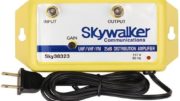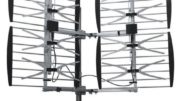To Balun or Not to Balun That TV antenna? When should it be done?
In an article of mine published in Popular Communications, January 2013, “An Omnidirectional DTV Antenna – With Gain,” I included a little bit about why I was no longer using the 4 to 1 (4:1) balun to convert my twin lead to my TV’s 75 Ohm antenna input. I also asked for reader input and posed some questions. I think some of the questions are now answered and that the baluns I have are working correctly.
My reasoning was that when I did this for the bowtie antenna using twinlead feed line, I noticed my TV got a better signal without the balun than with it.
I think I now have a better handle on the reason. Recently (September/August 2012), I built two four-element bowtie turnstile TV antennas. One was a dipole design and the other was the full-wave loop design.
The dipole antenna has a design impendence of about 73 Ohms while the full-way loop has the design impendence of 300 Ohms.
“Ideally, a half-wave (Lamda/2) dipole should be fed with a balanced line matching the theoretical 73 ohm impedance of the antenna. A folded dipole uses a 300 ohm balanced feeder line.” – Dipole antenna – Wikipedia, the free encyclopedia
With the dipole design, I found that using a balun was not only of no real help, it actually made the signal measurably worse.
On the other hand, more experience has now shown that for an antenna based on a full-wave loop with a nominal design impendence of 300 Ohms, not using a 4:1 balun actually made matters worse and using the balun made the reception noticeably better.
When trying to decide when to use a balun, no matter which feed line you’re using, base the decision only on the design impedance of the antenna and not on the feed-line being used. So, in the case of using 300 Ohm feed-line to a 72 Ohm Bowtie (dipole) antenna, do not use a 4:1 balun. But, if you’re using a folded-dipole (fullwave loop) antenna with a design impedance of 300 Ohms, use the 4:1 balun some time before attaching it to the 75 Ohm TV input.
This also probably answers the question as to why all bowtie antennas came with 300 Ohm fee line. It is because: 1. The 300-Ohm feed line is very low loss. 2. The TV had 300-Ohm input connections. 3. Even today, no balun is needed, even with the 300-Ohm feed line.
Of course, it could all be due to the manufacturers not wanting to change the production line to use coax instead of the twin lead.
Now for the antenna test.
Inclement Weather Antenna Test results
Oct 29, 2012: Here are the results of the Hurricane Sandy tests of my Turnstile-Bowtie antenna. The building article about this antenna will be published in Popular Communications in the January 2013 issue. http://www.popular-communications.com/
I have a single element Turnstile-Bowtie antenna above the kitchen on a mast with my 144MHz/440MHz J-Pole antenna attached to the chimney. So it’s up about 20+ feet above the ground and about 25 feet or more higher than the 4-element Turnstile-Bowtie antenna (TBA4).
The TBA4 is in the garage and to get Baltimore stations, it is going through the garage wall or perhaps the metal door. Neither the wall nor the door have windows. The neighbor’s house or trees may be in the way.
That’s the line-of-sight situation as near as I can figure it.
The result on Monday, October 29th, during the start of Hurricane Sandy during a heavy rain, was that the TV in the kitchen was flaking out on all Baltimore major network stations NBC, CBS, and ABC, while MPT Ch 67 was solid. Fox 45 wasn’t even solid during a light rain. MPT Ch 62 was MIA.
The TBA4 antenna was receiving all major stations solidly NBC, CBS, and ABC, while MPT Ch 67 and 62 were both solid. Fox 45 wasn’t even solid during a light rain.
What a difference! The TBA4 is working beautifully while in the garage I look forward to seeing what it does once I get it in the air!
Phil Karras, KE3FL
All my articles are listed here.





